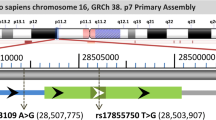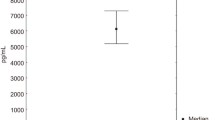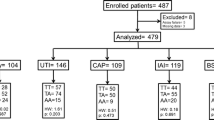Abstract
Objective
To investigate the -1082 (A/G) polymorphism in the promoter of the IL-10 gene in terms of IL-10 production from stimulated peripheral blood mononuclear cells (PBMC) and to evaluate the relationship of this polymorphism with susceptibility to severe sepsis and the outcome of the disease.
Design
Case-control study.
Setting
Research laboratory of Molecular Biology and Immunology and University Hospital ICU, Faculty of Medicine, Trakia University.
Patients
A total of 53 healthy volunteers and 33 patients in ICU meeting the criteria for severe sepsis were included.
Measurements and results
The amplification refractory mutation system PCR was used for IL-10-1082 polymorphism detection. Isolated PBMC were stimulated with either C3-binding glycoprotein (C3bgp), lipopolysaccharide (LPS), phytohemagglutinin (PHA),or pokeweed mitogen (PWM). IL-10 production was measured in culture supernatants. The AA genotype was associated with lower IL-10 production in LPS-, PHA- or PWM-stimulated healthy PBMC. Patients with severe sepsis had significant elevation of A allele, compared with healthy controls (74.2% vs 52.8%; p = 0.0062). Carriage of at least one copy of IL-10-1082 G allele in sepsis patients and in healthy controls resulted in a statistically significant increase in IL-10 production from stimulated PBMC. Surviving sepsis patients had a significant decrease of IL-10-1082 allele G frequency, compared with controls (17% vs 47.2%; p = 0.012). An association between increased IL-10 production and poor outcome from sepsis was observed.
Conclusion
The A allele of the -1082 polymorphism in the interleukin-10 gene promoter is associated with sepsis susceptibility, whereas G allele is associated with higher stimulated interleukin-10 production and increased mortality in severe sepsis.


Similar content being viewed by others
References
van Deventer SJH (2000) Cytokine and cytokine receptor polymorphism in infectious disease. Intensive Care Med 26:S98–S102
Stuber F (2001) Effect of genomic polymorphisms on the course of sepsis: Is there a concept for gene therapy? J Am Soc Nephrol 12:S60–S64
Sfeir T, Saha DC, Astiz M, Rackow EC (2001) Role of interleukin-10 in monocyte hyporesponsiveness associated with septic shock. Crit Care Med 29:129–133
Gomez-Jimenez J, Martin MC, Sauri R, Segura RM, Esteban F, Ruiz JC, Nuvials X, Boveda JL, Peracaula R, Salgado A (1995) Interleukin-10 and the monocyte/macrophage- induced inflammatory response in septic shock. J Infect Dis 171:472–475
Lyons A, Kelly JL, Rodrick ML, Mannick JA, Lederer JA (1997) Major injury induces increased production of interleukin-10 by cells of the immune system with a negative impact on ressistance to infection. Ann Surg 226:450–458
Oberholzer A, Oberholzer C, Moldawer LL (2002) Interleukin-10: A complex role in the pathogenesis of sepsis syndromes and its potential as an anti-inflammatory drug. Crit Care Med 30:S58–SS63
Latifi SQ, O'Riordan MA, Levine AD (2002) Interleukin-10 controls the onset of irreversible septic shock. Infect Immun 70:4441–4446
Kahlke V, Dohm C, Mees T, Brotzmann K, Schreiber S, Schroder J (2002) Early interleukin-10 treatment improves survival and enhances immune function only in males after hemorrhage and subsequent sepsis. Shock 18:24–28
Stanilova SA, Karakolev ZT, Dimov GS, Dobreva ZG, Miteva LD, Slavov ES, Stefanov CS, Stanilov NS (2005) High interleukin-12 and low interleukin-10 production after in vitro stimulation detected in sepsis survivors. Intensive Care Med 31:401–407
Turner DM, Williams DM, Sankaran D, Lazarus M, Sinnott PJ, Hutchinson IV (1997) An investigation of polymorphism in the interleukin-10 gene promoter. Eur J Immunogenet 24:1–8
D'Alfonso S, Rampi M, Rolando V, Giordano M, Momigliano-Richiardi P (2000) New polymorphisms in the IL-10 promoter region. Genes Immun 1:231–233
Eskdale J, Galager G (1995) A polymorphic dinucleotide repeat in the human IL-10 promoter region. Immunogenetics 42:444–445
Eskdale J, Kube D, Tesch H, Gallagher G (1997) Mapping of the human IL-10 gene and further characterization of the 5' flanking sequence. Immunogenetics 46:120–128
Eskdale J, McNicholl J, Wordsworth P, Jonas B, Huizinga T, Field M, Gallagher G (1998) Interleukin-10 microsatellite polymorphisms and IL-10 locus alleles in rheumatoid arthritis susceptibility. Lancet 352:1282–1283
D'Alfonso S, Rampi M, Bocchio D, Colombo G, Scorza-Smeraldi R, Momigliano-Richardi P (2000) Systemic lupus erythematosus candidate genes in the Italian population: Evidence for a significant association with interleukin-10. Arthritis Rheum 43:120–128
Lowe PR, Galley HF, Abdel-Fattah A, Webster NR (2003) Influence of interleukin-10 polymorphisms on interleukin-10 expression and survival in critically ill patients. Crit Care Med 31:34–38
Schaaf BM, Boehmke F, Esnaashari H, Seitzer U, Kothe H, Maass M, Zabel P, Dalhoff K (2003) Pneumococcal septic shock is associated with the interleukin-10–1082 gene polymorphism. Am J Respir Crit Care Med 168:476–480
Shu Q, Fang X, Chen Q, Stuber F (2003) IL-10 polymorphism is associated with increased incidence of severe sepsis. Chin Med J (Engl) 116:1756–1759
American College of Chest Physicians/Society of Critical Medicine Consensus Committee (1992) Definitions for sepsis and organ failure and guidelines for the use of innovative therapies in sepsis. Crit Care Med 20:864–874
Zhelev ZD, Stanilova SA, Carpenter BG (1994) Isolation, partial characterisation and complement inhibiting activity of a new glycoprotein from Cuscuta europea. Biochem Biophys Res Commun 202:186–194
Cavet J, Middleton P, Segal M, Noreen H, Davies S, Dickinson A (1999) Recipient tumor necrosis factor and interleukin-10 gene polymorphisms associate with early mortality and acute graft-versus-host disease severity in HLA-matched sibling bone marrow transplants. Blood 94:3941–3946
Stanilova S, Dobreva Z, Slavov E, Miteva L (2005) C3-binding glycoprotein from Cuscuta europea induced different cytokine profiles from human PBMC compared to other plant and bacterial immunomodulators. Int Immunopharmacol 5:723–734
Crawley E, Kay R, Sillibourne J, Patel P, Hutchinson I, Woo P (1999) Polymorphic haplotypes of the interleukin-10 5′ flanking region determine variable interleukin-10 transcription and are associated with particular phenotypes of juvenile rheumatoid arthritis. Arthritis Rheum 42:1101–1108
Paterson JCM (1999) Inherited haplotypes of the interleukin-10 promoter differentially regulate gene transcription. Joint Congress of the BSI and the BSACI, abstract OP258
Eskdale J, Keijsers V, Huizinga T, Gallagher G (1999) Microsatellite alleles and single nucleotide polymorphisms (SNP) combine to form four major haplotype families at the human interleukin-10 (IL-10) locus. Genes Immunity 1:151–155
Keijsers V, Verweij CL, Hazes JMW, Westendorp RGJ, Breedveld FC, Huizinga TWJ (1998) Innate differences in IL-10 production are present at the level of transcription and associated with haplotypes: association of IL-10 haplotypes and rheumatoid arthritis. Clin Exp Rheumatol 16:200
Rees LE, Wood NA, Gillespie KM, Lai KN, Gaston K, Mathieson PW (2002) The IL-10-1082 G/A polymorphism: allele frequency in different populations and functional significance. Cell Mol Life Sci 59:560–569
Gaston K, Fried M (1995) CpG methylation has differential effects on the binding of YY1 and ETS proteins to the bi-directional promoter of the Surf-1 and Surf-2 genes. Nucleic Acids Res 23:901–909
Stanilova S, Miteva L (2005) Taq-I polymorphism in 3'UTR of the IL-12 and association with IL-12p40 production from human PBMC. Genes Immun 6:364–366
Gogos C, Drosou E, Bassaris H, Skoutelis A (2000) Pro versus anti-inflammatory cytokine profile in patients with severe sepsis: a marker for prognosis and future therapeutic options. J Infect Dis 181:176–180
Murray PJ, Wang L, Onufryk C, Tepper RI, Young RA (1997) T-cell-derived IL-10 antagonizes macrophage function in mycobacterial infection. J Immunol 158:315–321
Van der Poll T, Marchant A, Keogh CV, Goldman M, Lowry SF (1996) Interleukin-10 impairs host defense in murine pneumococcal pneumonia. J Infect Dis 174:994–1000
Gallagher P, Lowe G, Fitzgerald T, Bella A, Greene C, McElvaney N, O'Neill S (2003) Association of IL-10 polymorphism with severity of illness in community acquiring pneumonia. Thorax 58:154–156
Author information
Authors and Affiliations
Corresponding author
Rights and permissions
About this article
Cite this article
Stanilova, S.A., Miteva, L.D., Karakolev, Z.T. et al. Interleukin-10-1082 promoter polymorphism in association with cytokine production and sepsis susceptibility. Intensive Care Med 32, 260–266 (2006). https://doi.org/10.1007/s00134-005-0022-4
Received:
Accepted:
Published:
Issue Date:
DOI: https://doi.org/10.1007/s00134-005-0022-4




